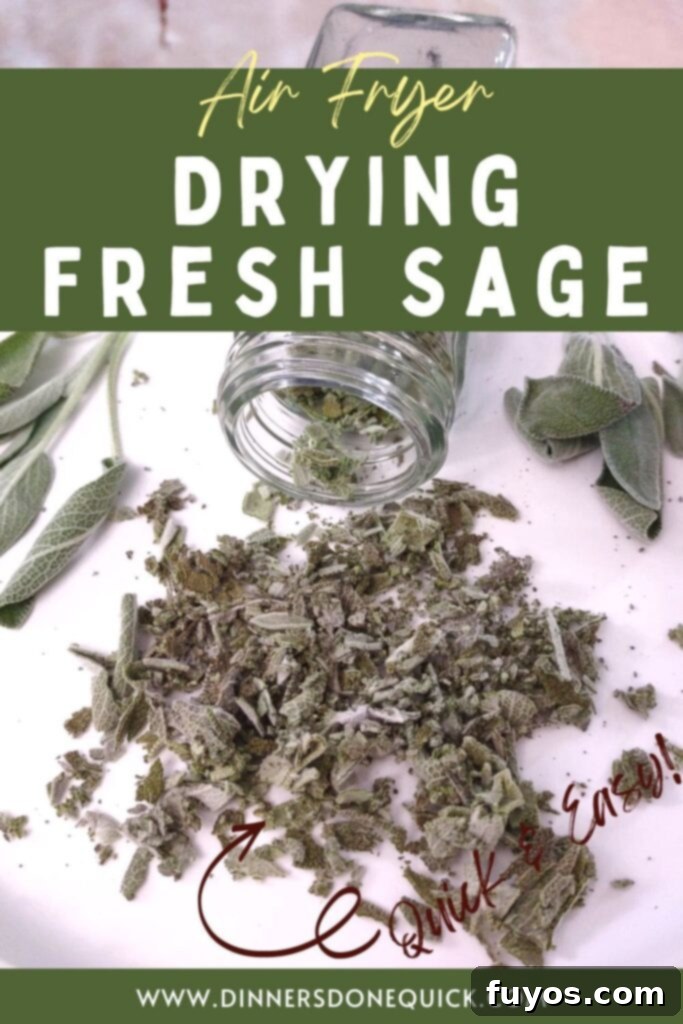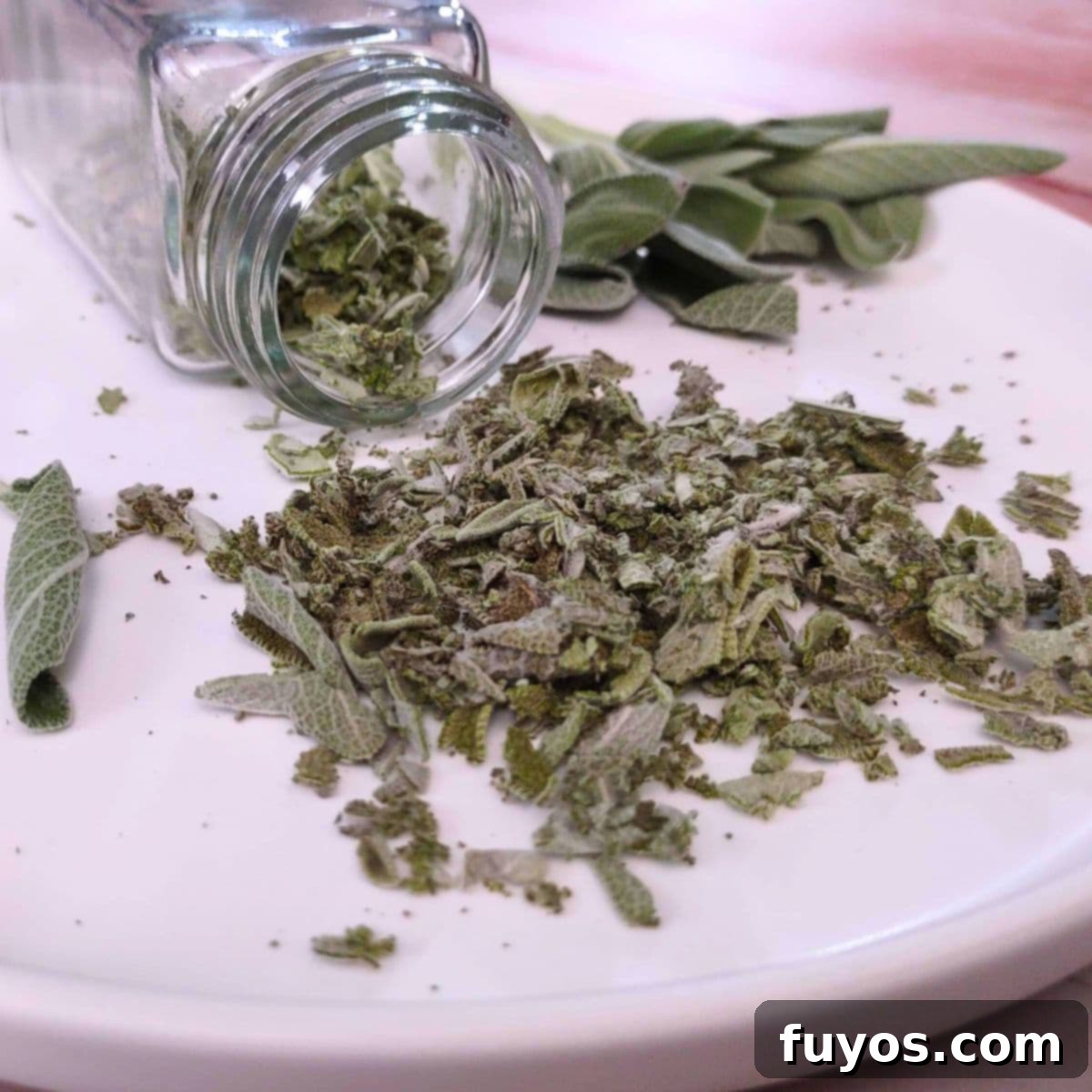How to Dry Sage in an Air Fryer: Quick, Easy & Flavorful Homemade Dried Herbs
After enjoying a delicious roasted chicken dinner, I found myself with a generous amount of leftover fresh sage leaves. The thought of letting them go to waste was simply unacceptable! That’s when inspiration struck: why not dehydrate them? I’m excited to share with you just how incredibly easy it is to dry sage in the air fryer, so you can also effortlessly preserve your fresh herbs and enjoy their aromatic flavor for months to come.
Using an air fryer is a game-changer for preserving herbs, offering a rapid and efficient method. However, if you don’t own an air fryer or are curious about alternative techniques, you can also learn how to dry sage in the microwave for another speedy solution!
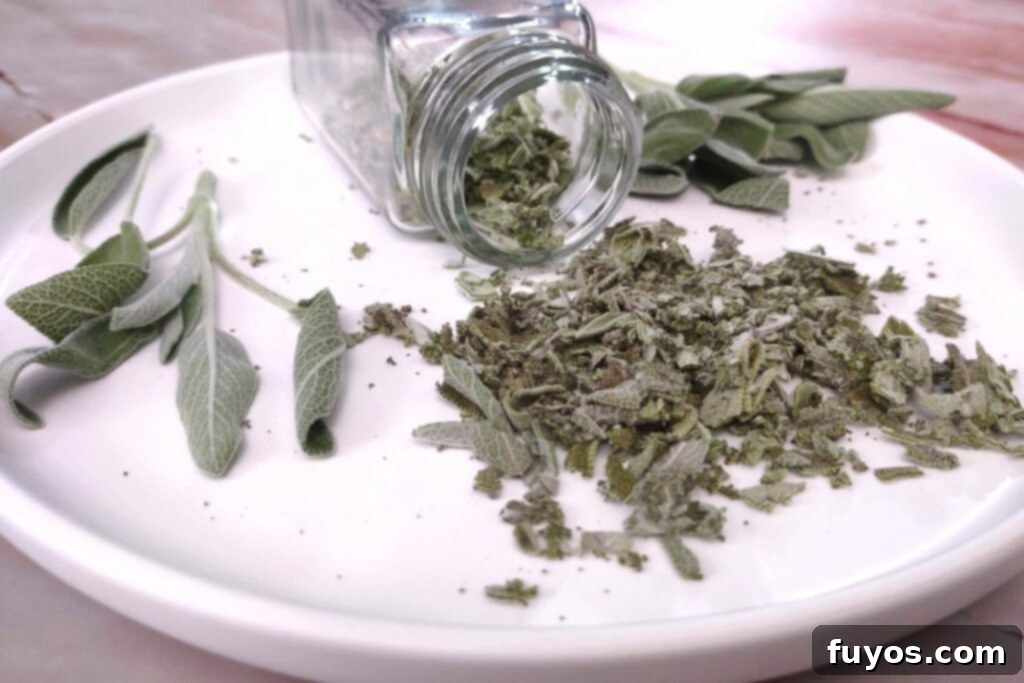
Can I Dry Sage in an Air Fryer? Absolutely!
Yes, you absolutely can dry sage in an air fryer, and it’s one of the most efficient methods out there!
In fact, air frying sage stands out as one of the quickest and simplest ways to dehydrate this fragrant herb. Unlike other methods, such as traditional oven drying or even microwave drying, the air fryer often allows you to keep the sage leaves on their stems during the initial drying phase. This significantly cuts down on prep time, making the entire process even more convenient for busy home cooks.
The circulating hot air within the air fryer creates an ideal environment for rapidly removing moisture from the sage leaves, resulting in perfectly dried, brittle herbs in a fraction of the time it would take using conventional methods. It’s a fantastic hack for anyone looking to maximize the shelf life of their fresh produce.
Katie’s Quick Tip
The air fryer isn’t just great for sage; it’s a versatile tool for drying many other herbs too! Learn how to dry rosemary in the air fryer for another robust herb that frequently complements sage in savory dishes.
Quick + Easy Recipes
straight to your inbox
Why Choose the Air Fryer for Drying Sage?
While various methods exist for drying herbs, the air fryer offers distinct advantages that make it a top choice, especially for sage:
- Speed: Forget waiting hours or days. The air fryer can perfectly dry sage in mere minutes, making it ideal for impromptu herb preservation.
- Efficiency: Compared to turning on a large oven for a small batch of herbs, an air fryer uses significantly less energy, saving you on utility bills.
- Consistent Results: The powerful circulation of hot air ensures even drying, reducing the risk of soggy spots or overcooked edges.
- Ease of Use: The process is incredibly straightforward, requiring minimal oversight once you’ve set the temperature and time.
- Maintains Flavor: Quick drying at a controlled temperature helps preserve the sage’s natural aroma and robust flavor profile more effectively than slower, open-air methods.
How to Dry Sage in the Air Fryer: Step By Step Guide
Follow these simple steps to transform your fresh sage into perfectly dried, ready-to-use herbs in no time. This method is designed for efficiency and optimal results.
- Prepare Your Sage: Wash and Dry Thoroughly
If your sage has any visible dirt or debris, gently wash it under cool running water. The most crucial part of this step is to dry the sage completely. Excess moisture can lead to steaming instead of drying, resulting in soggy herbs or even mold. You can gently pat the sage dry with paper towels or use a salad spinner for a more efficient dry. Ensure there are no lingering water droplets before proceeding.
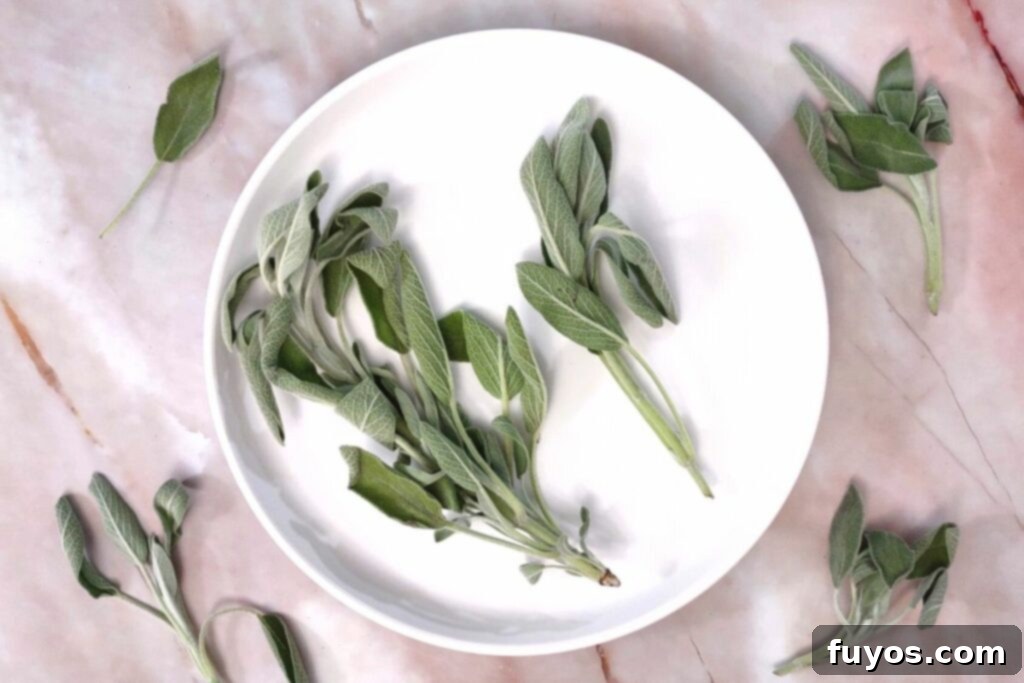
- Preheat Your Air Fryer to 350°F (175°C)
Preheating is vital for even drying. Just like baking, placing ingredients into an already hot environment helps kickstart the dehydration process immediately and consistently. Give your air fryer a few minutes to reach the target temperature.
- Arrange Sage in the Air Fryer Basket in a Single Layer
Carefully place the sage bunches or individual leaves into the preheated air fryer basket. The goal is to keep them in as close to a single layer as possible. Overlapping leaves can create “wet pockets” where moisture gets trapped, preventing uniform drying. If you have a large amount of sage, work in batches to ensure every leaf gets optimal airflow. This is key to achieving perfectly crispy dried sage.
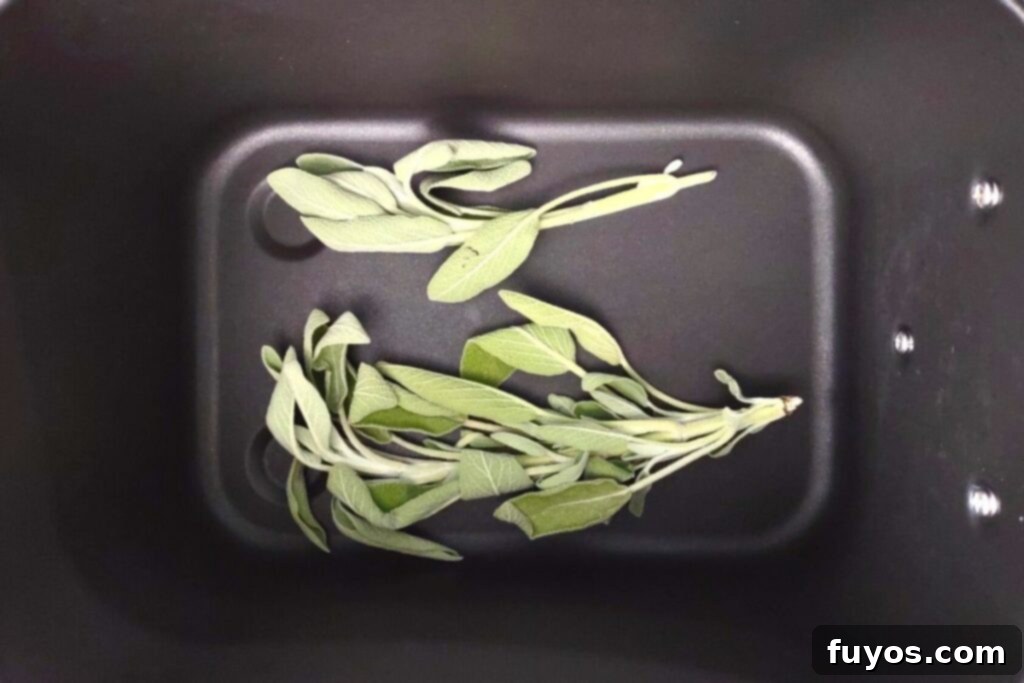
- Secure the Sage to Prevent Blowing Around
During air frying, the powerful fan can cause lightweight sage leaves to fly around inside the basket, leading to uneven drying or even burning if they hit the heating element. To prevent this, cover the sage with an air fryer rack, a metal trivet, or even a small, heat-safe ceramic plate. If you don’t have these, you can bundle the sage bunches together by their stems with a heat-safe tie (like butcher’s twine), creating a more stable mass.
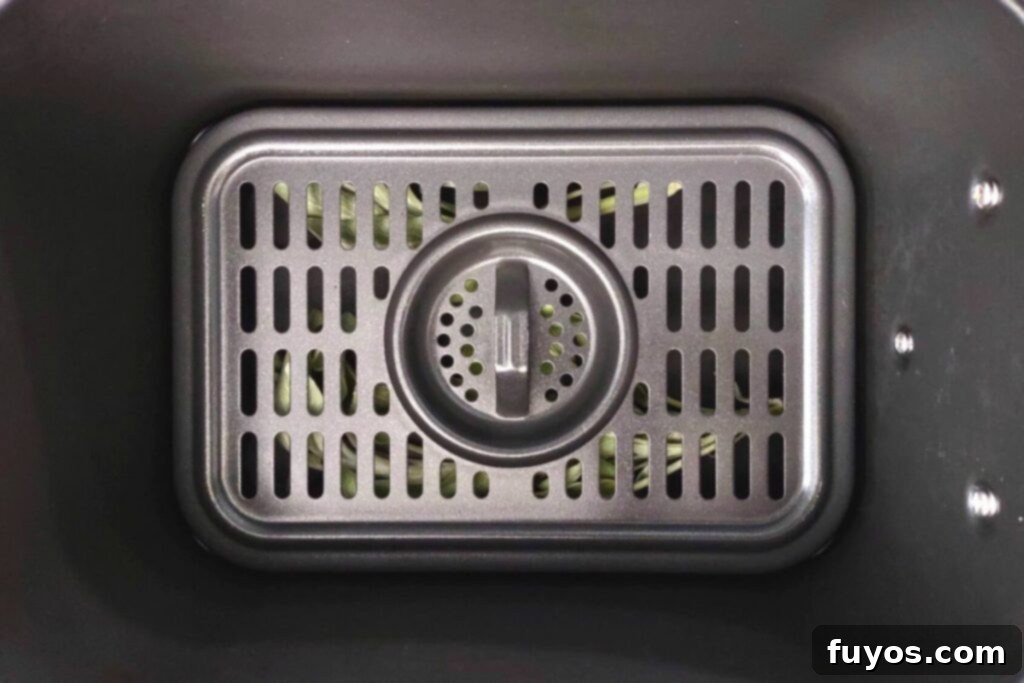
- Air Fry for 3 Minutes at 350°F (175°C)
Cook the sage on the air fry setting. For most air fryer models, 3 minutes at 350°F is a perfect starting point. The circulating hot air will quickly draw out the moisture, transforming the fresh leaves into brittle, dried herbs.
- Check for Doneness: Look for Curled, Dry, Crackling Leaves
Sage is fully dried when the leaves have visibly curled inwards, appear completely dry, and feel crispy. When you gently touch or crinkle them, they should make a distinct crackling sound and easily crumble. This indicates all the moisture has been removed.
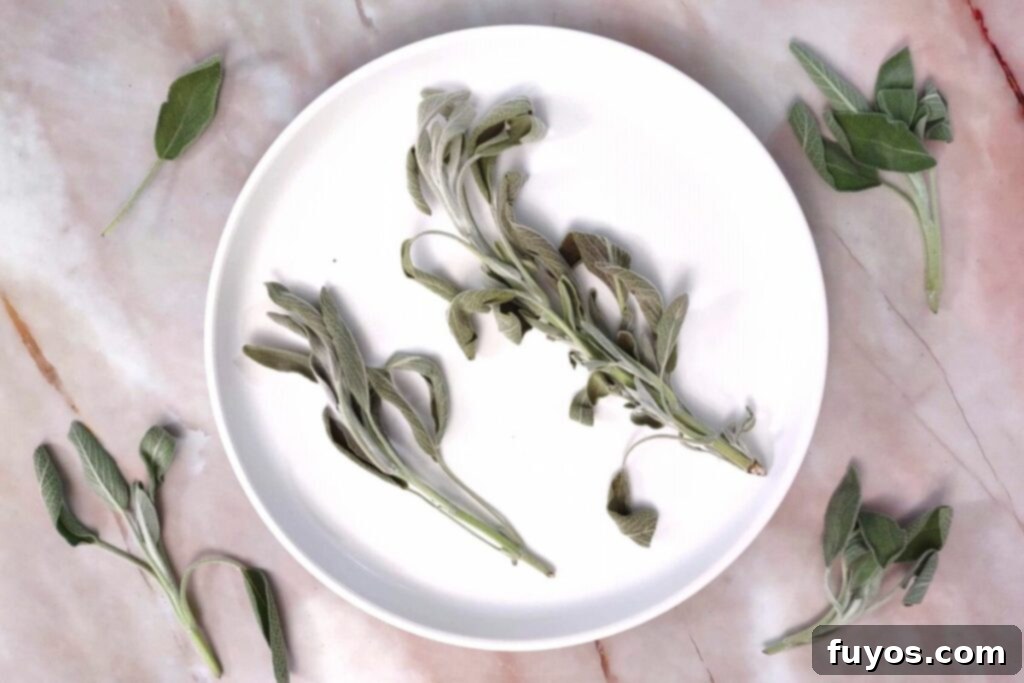
- Add Additional Time in 1-Minute Increments if Needed
If your sage isn’t fully dry after 3 minutes, or if you have a particularly moist batch, add extra cooking time in 1-minute increments. It’s crucial to check frequently for doneness to prevent burning, as sage can go from perfectly dry to overcooked very quickly. Different air fryer models and the moisture content of your sage can affect the total drying time.
- Remove Sage Leaves from Stems with a Simple Technique
Once cooled slightly, removing the dried sage leaves from their stems is incredibly easy. Hold the dehydrated sage bunch over a plate or bowl by the stem with one hand. With your other hand, gently squeeze the leaves from the bottom of the stem upwards. The brittle leaves will effortlessly drop onto your plate. For any stubborn leaves, rub your thumb and index finger together along the stem.

- Crush the Leaves to Your Desired Consistency
Now that your sage is perfectly dry, you can prepare it for storage. If you prefer larger flakes, simply crush the leaves with your fingers. For a finer, more dust-like consistency, ideal for rubs or marinades, use a mortar and pestle or even a small spice grinder. This allows you to customize your homemade dried sage to suit various culinary applications.

- Store in an Airtight Container
Proper storage is essential to maintain the potency and shelf life of your newly dried sage. Transfer the crushed sage into an airtight container, a clean spice jar, or a sealable bag. Store it in a cool, dark place away from direct sunlight and heat, which can degrade its flavor and color. Label with the date of drying so you know exactly how fresh it is.

For best results, it’s important to try and keep the sage leaves in as close to a single layer as possible during drying. This ensures uniform exposure to the circulating hot air, preventing any “wet pockets” from forming. Since the process only takes a few minutes per batch, it’s not too much trouble to cook your sage in multiple small batches if necessary, guaranteeing perfectly dehydrated herbs every time.
From my experience, it typically takes about 3 to 3 ½ minutes in total in a Ninja Foodi Dual Zone air fryer to completely dry a batch of sage. However, drying times can vary slightly depending on the specific brand, model, and wattage of your air fryer, as well as the initial moisture content of your fresh sage. Always monitor your sage closely during the last minute to prevent overcooking.
Sage typically maintains a lovely green color during the air frying dehydration process, though some very light browning around the edges is perfectly normal. If you notice your sage leaves turning a dark brown or black color, this indicates they have been overcooked. While still usable, the flavor potency might be diminished, and they might have a slightly bitter taste.
Katie’s Quick Tip
The effortless “scrunching” process to remove leaves from stems also works incredibly well on other air-fried herbs, such as parsley dehydrated in the air fryer!
Is Sage Better Fresh or Dried? Exploring the Best Form for Your Dishes
This is a common question among cooks, and the answer often depends on the specific culinary application and desired intensity. As with most herbs, fresh sage is generally more potent and vibrant in flavor due to its higher oil content. It offers a bright, slightly peppery, and pine-like aroma that can truly elevate a dish.
However, “better” doesn’t solely mean stronger. Dried sage offers distinct advantages that often make it the more practical and versatile choice:
- Extended Shelf Life: This is arguably the biggest benefit. Fresh sage wilts quickly, typically lasting only a week or two in the refrigerator. Properly stored dried sage, on the other hand, can retain its flavor and aroma for about 1-3 years (Source). This makes it incredibly convenient to have on hand whenever a recipe calls for it, without worrying about spoilage.
- Convenience and Availability: Dried sage is always ready to go. You don’t need to make a special trip to the grocery store or worry about having fresh sprigs on hand.
- Versatility in Form: Dried sage can be easily crushed or powdered, allowing for seamless incorporation into marinades, spice rubs, compound butters, or when you want the flavor to distribute evenly without noticeable leaf pieces. Achieving a similar fine texture with fresh sage is much more challenging.
- Concentrated Flavor: While less “bright” than fresh, the flavor of dried sage is more concentrated. This means you generally use less dried sage than fresh (a common rule of thumb is 1 teaspoon of dried herbs for every 1 tablespoon of fresh). This makes it powerful for long-cooking dishes like stews, soups, and roasts where the flavor has time to meld.
While the immediate burst of flavor from fresh sage is undeniable, the long-term convenience, versatility, and concentrated essence you get from homemade dried sage often make it the superior choice for everyday cooking and pantry stocking.
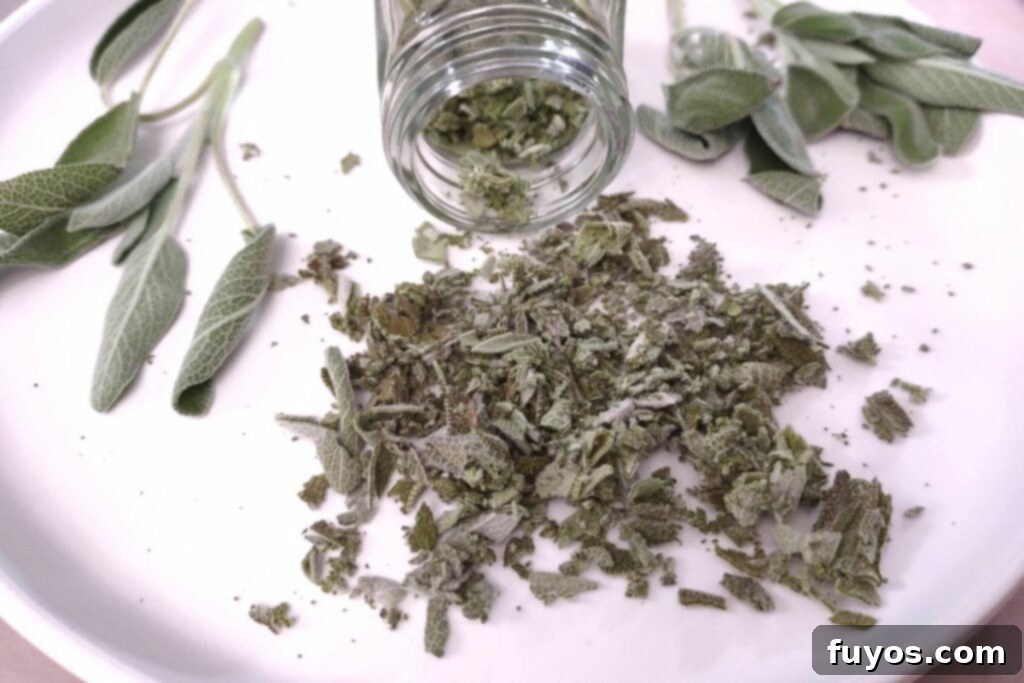
Culinary Uses for Your Homemade Dried Sage
Now that you have a stash of homemade dried sage, the culinary possibilities are endless! Sage is a deeply aromatic herb with a warm, earthy, and slightly peppery flavor that pairs wonderfully with a variety of ingredients, especially in fall and winter dishes. Here are some popular ways to use your air-fried dried sage:
- Poultry: Sage is a classic companion to chicken, turkey, and duck. Use it in rubs for roasting, sprinkle it over grilled chicken, or incorporate it into poultry stuffing.
- Stuffing and Dressings: An essential ingredient for holiday stuffings, adding that signature savory depth.
- Root Vegetables: Roasting vegetables like butternut squash, sweet potatoes, carrots, and parsnips with dried sage creates a harmonious and comforting side dish.
- Soups and Stews: Add a pinch to creamy squash soups, hearty bean stews, or a rich mushroom soup for an earthy undertone.
- Pork Dishes: Sage and pork are a match made in heaven. Use it in pork chops, pork roasts, or even sage sausage.
- Pasta and Sauces: Incorporate into brown butter sage sauce for gnocchi or ravioli, or add to tomato-based sauces for a rustic flavor.
- Compound Butter: Mix finely crushed dried sage with softened butter, then roll and chill to create a flavorful butter perfect for slathering on bread, vegetables, or poultry.
- Homemade Bread: Knead some dried sage into your bread dough for an aromatic loaf.
With your own dried sage, you’re ready to infuse your cooking with incredible flavor all year long!
Frequently Asked Questions About Drying Sage in an Air Fryer
How long does air-fried sage last?
When properly dried and stored in an airtight container in a cool, dark place, homemade dried sage can last for 1 to 3 years. Its potency will gradually diminish over time, so it’s best to use it within a year for optimal flavor.
Can I dry other herbs in the air fryer using this method?
Yes, the air fryer is fantastic for drying many other herbs! Rosemary, thyme, oregano, and parsley all dehydrate beautifully in the air fryer using similar temperatures and short cooking times. Just be sure to watch them closely, as drying times may vary slightly based on the herb’s thickness and moisture content.
What’s the best temperature to dry herbs in an air fryer?
A temperature of 350°F (175°C) is ideal for quickly dehydrating sage and most other herbs in an air fryer. This temperature is hot enough to remove moisture rapidly without “cooking” or burning the delicate leaves, helping to preserve their color and flavor.
Do I need to wash sage before drying?
It’s recommended to gently wash your sage leaves if they have any visible dirt or residue. However, the most critical step after washing is to ensure they are thoroughly dried before placing them in the air fryer. Excess moisture will lead to steaming and poor drying results.
Final Thoughts on Air Fryer Dried Sage
Preserving fresh herbs doesn’t have to be a complicated or time-consuming task. As you’ve seen, sage is an herb that truly dehydrates wonderfully, and the process is only made easier when you choose to dry sage in the air fryer. It stands out as one of the quickest and most straightforward methods available, making it remarkably easy for even a beginner to achieve perfectly dried herbs.
By transforming your fresh sage into a convenient, shelf-stable form, your air fryer becomes an invaluable tool for extending your kitchen’s capabilities. Use your delicious homemade dried sage in a wide variety of fall-inspired dishes, hearty roasts, savory stuffings, and so many other culinary creations. Its robust, earthy flavor pairs exceptionally well with poultry, various types of squash, comforting soups, and rich gravies.
If you love cooking with squash and want to explore more air fryer magic, then be sure to take a look at my favorite air fryer butternut squash recipes to try today!
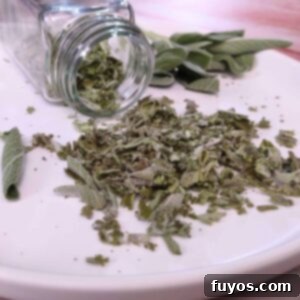
Simple Air Fryer Dried Sage
Equipment
-
Air Fryer
-
Trivet, rack, or heat safe ties
Ingredients
- 2-3 bunches Fresh Sage leaves washed and thoroughly dried if needed
Instructions
-
Preheat your air fryer to 350°F (175°C).
-
Place the fresh sage bunches (or individual leaves) in the preheated air fryer basket, ensuring they are in as close to a single layer as possible.2-3 bunches Fresh Sage leaves
-
Cover the sage with an air fryer rack, trivet, or small heat-safe plate to prevent the leaves from blowing around. If you don’t have one, bundle the bunches together by the stems with a heat-safe tie.
-
Cook sage on the air fry setting for 3 minutes at 350°F (175°C).
-
Sage is done when the leaves have curled in, appear completely dry and crispy, and crackle when gently touched or crinkled.
-
If additional time is needed, add in increments of 1 minute and check frequently for doneness to prevent burning.
-
To remove sage leaves from stems (once slightly cooled), hold the dehydrated sage over a plate by the stem with one hand, and squeeze from bottom to top with the other. This will cause the leaves to easily drop onto the plate. Rub your thumb and index finger together to loosen any stuck leaves.
-
If desired, crush the leaves up finer using your fingers for flakes, or a mortar and pestle (or spice grinder) if you want a highly ground, dust-like consistency.
-
Store in an airtight container, spice jar, or similar, in a cool, dark place. Label with the date.
Notes
- 3 bunches of sage leaves typically yield around 1 tablespoon of ground, dried sage, depending on the specific size and density of your fresh bunches.
- I usually achieve fully dehydrated sage in approximately 3 to 3 ½ minutes in my Ninja Foodi Dual Zone air fryer. Please note that drying times may vary slightly based on your specific air fryer model and its wattage.
- It’s crucial to arrange the sage in as close to a single layer as possible. Overlapping leaves can create trapped moisture, leading to wet spots and uneven drying.
- You will observe the leaves curling inwards as they cook and dehydrate.
- Some light browning or a slight gray tint is a normal part of the drying process. However, if the leaves turn dark brown or black, it indicates overcooking, which can result in a loss of flavor and a slightly bitter taste.
Nutrition
Number of total servings shown is approximate. Actual number of servings will depend on your preferred portion sizes.
Nutritional values shown are general guidelines and reflect information for 1 serving using the ingredients listed, not including any optional ingredients. Actual macros may vary slightly depending on specific brands and types of ingredients used.
To determine the weight of one serving, prepare the recipe as instructed. Weigh the finished recipe, then divide the weight of the finished recipe (not including the weight of the container the food is in) by the desired number of servings. Result will be the weight of one serving.
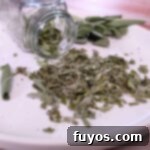
Did you try this recipe?
Mention @TheDinnersDoneQuick or tag #dinnersdonequick! for even more!
Pin Recipe
Leave A Review
